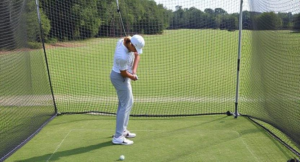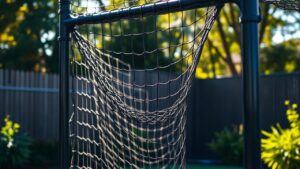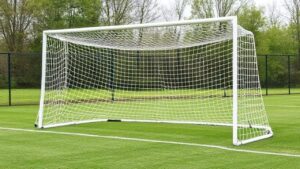Why do we even worry about sports nets for training? Are they a necessity, or just another overpriced bit of junk that marketers make people pay for?” That question succinctly summarizes the controversy surrounding training sports nets. For some, they are really essential tools that can help elevate the performance of an athlete to new heights. For others, they are just another flashy product made by companies manufacturing sports gear to turn a profit.
Are they really essential for training, or have we fallen victim to a clever sales pitch? Let’s examine their place in modern sports nets, the impact on performance, what makes them special, and whether their benefits outweigh the price. Training sports nets have earned a niche for themselves in many sports. Whether it’s soccer, basketball, cricket, or tennis, what these nets do is help to deliver whatever is necessary to every athlete at every single level.
Many also find these nets overpriced accessories catering more to marketing hype than real utility. Their supporters, however, strongly advocate for the role of sports nets for training. They point out how these nets enhance the efficiency of sporting activities, enable athletes to fine-tune their techniques, and reduce the dangers of suffering injuries during practice.
What Are Sports Nets for Training and Why Do They Pose a Controversy?

Sports Nets for Training nets are specialized gear used to help athletes exercise in controlled, varied environments. From the soccer nets and basketball nets to cricket and tennis, these varying sizes, materials, and configurations all serve unique purposes for each different game. For instance, portable soccer nets help players practice shooting accuracy, while cricket nets allow for safe and efficient batting and bowling drills. Whether it’s for beginners learning the basics or professionals fine-tuning their skills, these nets are marketed as essential tools that provide structure, safety, and focus during training sessions.
Despite their widespread use, sports nets for training have sparked considerable debate. Critics question their necessity, often dismissing them as overpriced luxuries. “Can a piece of mesh really define your success? ” they ask, arguing that the essence of sports lies in raw talent and determination, not reliance on accessories.
Consumers who believe that this net is one of the many sports industry tendencies to make simple tools essential, increase rates without gaining adequate results. On the other hand, the supporters remain very strong. They argue that training nets are more than accessories; they are tools meant to improve performance, efficiency, and minimize the chance of injury. Sports nets for training provide a controlled environment through which individual athletes can hone specific skills, such as precision shooting or trajectory control of balls in ball games.
High-Performance Netting: The Buzzword Splitting Opinions
Talk of sports nets for training equipment, and one word leads the way: “high-performance netting.” But what does it mean?Usually, high-performance nets can be characterized by material solidity, but rather sturdy sport net materials like nylon and polyethylene. Another characteristic is versatility, where many nets are designed to be used both indoors and outdoors, which ensures adaptability in almost all training environments. Improvements include portable nets, rebound systems, and even custom configurations that cater to specific needs while promising convenience and innovation in one package.
Adding fuel to the fire is the aggressive marketing strategies of the top brands, which some accuse of taking advantage of the athletes by charging outrageous prices for their products. Here lies the dilemma: the balance between quality assurance and blatant profiteering. Some deliver excellent performance while others seem more interested in milking the trends rather than actually improving the athlete’s experience. This leaves athletes and coaches grappling with a tough question: how much of their investment in high-performance netting is truly about performance, and how much is about falling for marketing allure?
Essential or Expendable Sports Accessories?

The debate as to whether training nets are essential or expendable rages on, though those arguments run strong on both sides. Of course, a certain scenario does make a tangible difference:. For example, goal practice in soccer mostly depends on uses of sports nets to check for accuracy while cricket nets ensure safe batting and bowling practices that are mostly carried out by the professional athletes and coaches in structured training programs while vouching for such nets being an indispensable requirement for practicing all these sports nets for training.
To maintain a middle ground, one needs to understand who actually benefits from training nets. These nets can prove useful for kids and beginners who are just in structured learning, whereas amateur players may use them to practice drills on their own without anyone’s guide. Professionals need these nets at some point to perfect advanced moves. Different sports also influence the necessity of nets-a tennis player might need accuracy-based nets, but a basketball player will not find them as essential.
Yet, whether the training modern sports net are indispensable or dispensable is truly dependent on context. For some, they are an invaluable tool; for others, they constitute an optional luxury. This nuanced perspective ensures that their role in sports nets for training remains a subject of discussion rather than a foregone conclusion.
Are We Overlooking Accessibility?
Accessibility to high performance sports nets for training in these communities, in many instances, has been on an increase. The stiff prices of the nets make it an exclusive commodity because it is only accessible to those with enough money or institutional support. Premium options may seem to promise impressive and advanced features, which many a times is just too expensive for most athletes and sports programs to afford. Budget options may be available, but their dependability is usually a concern.
Companies are now beginning to take a slice of responsibility that provides a gap in equipping everyone with the need-to-haves of sports, is this enough for the companies to make essential sports nets for training accessories accessible to all? While some sports netting brands have undertaken certain initiatives to make the products accessible or have launched programs to benefit destitute societies, overall effort is inconsistent. Exploring more sustainable models of production and expanding outreach initiatives could be steps in the right direction to make high-performance nets available to athletes from all walks of life.
Athletic Gear Obsession—Are We Losing Sight of Real Training?
As the sports nets for training industry continues to push for “cutting-edge” gear, it’s worth asking whether we’re placing too much faith in products rather than in actual practice and skill development. Athletic gear obsession has gone to a fever pitch, wherein each manufacturer keeps putting out what is going to be the new performance-enhancing giant: nets with smart sensors, rebound systems, and ultra-durable materials. However, the question at hand would remain: are training nets overemphasized in the market?
Coaches and athletes, with the motivation of maximum performance, can be overly dependent on state-of-the-art durable sports nets and training equipment. Although these will certainly have an impact on specific aspects of training, athletes start to believe that they need the latest equipment to be effective rather than continuing to hone their skills in rigorous practice.
This brings us to the very old debate between old-school and modern training methods. In the old days, athletes relied on minimal sports equipment for mainly practicing fundamentals, muscle memory, and repetitive practice. Today’s tech-heavy approach offers convenience and precision but risks making athletes too reliant on technology. Learning from the days when training techniques were simple, emphasizing raw skill, mental toughness, and adaptability, rather than the latest piece of gear, could be a great lesson. There’s value in striking a balance between embracing technology and returning to the basics of training, in order to not let the athletes forget what really makes them successful: practice, dedication, and perseverance.
The Future of Training Sports Nets

The future of training nets for sports nets for training holds plenty of excitement in store. One of the most significant developments seen so far is the integration of sensors in smart nets to monitor performance data in real-time. Such nets allow an athlete insight into their technique, giving data on accuracy, speed, and trajectory. There are also new customization and modular trends, where the nets can adapt to changing training requirements, whether it is individual drills or team exercises.
Sustainability will also be one area in which the training nets of the future could experience great change. With increased pressure on industries to go environmentally friendly, sports nets for training brands now are beginning to look into more eco-friendly materials and manufacturing processes for athletic gear. Starting from biodegradable fibers to eco-friendly production processes, calls for environmentally conscious athletic gear continue to grow, with training nets not being an exemption. Brands that focus on sustainability may appeal to eco-conscious consumers but would also establish a benchmark for the industry in their entirety.
Affordability and inclusiveness will likely be the future as sports nets for training. Currently, high-performance nets are a luxury for many; however, through the advancements in technology and the improvement of methods, the cost of these nets will surely depreciate in the future. These predictions suggest that the coming years will find a market of a more affordable net, thus allowing more athletes access to wider ranges of this tool. Ultimately, the future market for training nets would balance quality and affordability so that all these athletes receive the tools they need, regardless of their financial background to succeed.
Conclusion
In summary, the debate on sports nets for training is far from one-dimensional. Although they are considered indispensable tools enhancing performance, improving precision, and reducing injury risks, some other overhyped products driven more by marketing than true athletic need. Another complication in the divide is the issue of accessibility; most athletes and sports programs cannot afford high-performance nets.
Another controversial aspect of obsession with the latest sports equipment design relates to the loss of real training because of the focus on technology, rather than developing fundamental skills and raw talent. The future of sports nets for training is in making them accessible and effective, but grounded in the solid fundamentals that would make one become a better athlete.
FAQs
1. Do training sports nets indeed improve one’s performance?
Well, sports nets for training enhance accuracy, repetition and safety in the drill, making them quite beneficial to any athlete, but actually their use depends on the sports nets for training and type of training.
2. Are high-performance nets too costly?
While high-performance nets are quite durable and use polymers like nylon or polyethylene and advanced designs that provide adaptability as well as durability, it is this extra technology and quality that makes them more expensive.
3. Can cheap nets from training substitute with the benefits of premium models?
Budget nets can only do the basic tasks but have little durability and special features as premium nets. Though still useful for casual practice, they wear away fairly fast.











